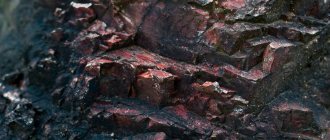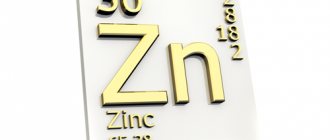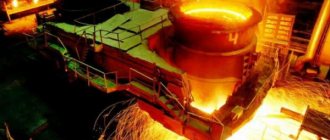The mixture of iron oxides formed by the interaction of oxygen with hot metal has a general name - iron scale. It consists of Fe3O4, FeO and Fe2O3 (magnetite, wustite and hematite, respectively) and is represented by two layers that are easily separated from each other. With a total thickness of up to 40 nm, scale is invisible to the naked eye; above 40 and up to 500 nm, it reveals itself as tarnished colors (rainbow tint). A permanent color appears if the layer of iron scale on the metal exceeds 500 nm.
Compound
The outer layer of iron oxide is hematite. It has great hardness (1030 units on the Vickers scale), abrasiveness and is very poorly soluble in acids. Beneath it, under conditions of partial oxygen deficiency, magnetite, which is softer and almost insoluble in acids, is formed. Closest to the metal is loose and soft wustite, which can be easily removed mechanically or by acid etching.
The thickness of each of the three layers depends on the processing temperature of the steel. Thus, when the threshold of 570 °C is exceeded, a clearly defined three-layer scale structure is formed. A further increase in temperature leads to an increase in the thickness of wustite. If steel is processed at temperatures below 570 °C, then the scale composition is dominated by magnetite and hematite.
The color of iron scale can be used to determine the processing temperature of steel. Thus, at a temperature of 700–750 °C, scale contains more hematite, which is why it acquires a reddish-red hue. The oxide layer formed during high-temperature (900–1000 °C) rolling becomes black due to a higher percentage of wustite.
Why is it necessary to remove the foreign body as soon as possible?
Any object that gets into the eye, regardless of size and origin, must be removed as quickly as possible for the following reasons:
- Any object from the environment is contaminated with microorganisms and is a potential source of infection, which develops well in the moist environment of the eye.
- The resulting inflammation in the outer membranes can easily spread to the deep eye tissues;
- A foreign body injures the eye tissue, the body’s defense system automatically tries to get rid of it and isolate itself from it. The flow of blood, lymph, and protective cells to the eye increases, thickening and clouding of tissue occurs, and a sharp decrease in vision;
- Metal foreign bodies, reacting with ocular moisture, form dangerous oxides that have a toxic effect on the tissues of the eye, change their structure, causing a sharp drop in vision, including retinal atrophy.
Even a small speck or grain of sand stuck in the membrane of the eyelids can lead to inflammation of the conjunctival-cartilaginous layer, deformation of the cartilage and the entire eyelid, to its inversion and loss of function, which will require complex plastic surgery.
Descaling
The layer of iron oxides from rolled steel is removed from the steel billet in several ways.
This is the cleanup:
- mechanical;
- chemical;
- electrochemical.
A combination of options is also possible.
The mechanical impact on rolled products is reduced to passing a wire or sheet with scale through a series of rollers. In this case, frequent bending of the workpiece is achieved, under the influence of which the iron scale crumbles into individual flakes and falls off the metal. For final cleaning, abrasives, sanding tapes, and wire brushes can be used.
The advantage of this technology is its comparative cheapness and environmental friendliness. But since the refusal of lubrication during such processing is impractical, this leads to oiling of the iron scale, which complicates its further processing.
Chemical and electrochemical methods for cleaning steel are called pickling. For these purposes, sulfuric and hydrochloric acids are used, less often - phosphoric, nitric, hydrofluoric acid or a mixture of them. The main disadvantages of this method are the one-time use of pickling solutions (they are not restored) and the low demand for the by-product of scale conversion - iron sulfate. For this reason, pickling is used quite rarely, and is usually preceded by mechanical cleaning of rolled metal from scale.
Peculiarities
The hardness of the scale is combined with its fragility, which is why inclusions of oxide inside the metal structure sharply reduce its performance characteristics. For the same reason, iron scale cannot be used as a protective coating, although it does not interact with oxygen. Moreover, at the site of oxide chipping, increased oxidation of steel is observed, which occurs due to the difference in potential between scale and steel. For this reason, it is removed from the finished product.
Read also: How to make alternating current 12v from direct current
Application of scale
Experienced blacksmiths have long noticed an increase in the resistance of metal to corrosion when a thin layer of scale is formed on it. Nowadays, gun steel bluing is used only as a decorative finish. Its color depends on the processing method (acid, alkali, temperature) and the thickness of the oxide film, ranging from 1 to 10 microns.
Rolling scale, the specific gravity of which reaches 3% of the total weight of finished products, is a valuable raw material for metallurgical production due to its high iron content (up to 75%). The main direction of its processing is purification from impurities and reduction, after which it turns into low-carbon steel.
Some scale compositions are successfully used as coloring pigments and are actively used in construction. Iron powder is also produced from scale, used in metallurgy, in the manufacture of self-heating mixtures, and even in the food industry.
The chemical composition of this waste from the metallurgical industry is standardized. Its cost may fluctuate depending on the predominance of certain types of oxides and the amount of impurities. The average price at the beginning of 2022 was 50 US dollars per ton of iron scale.
Rate this article:
Rating: 0/5 — 0 votes
The influence of scale on the formation of qualitative characteristics of the surface layer of hot-rolled strip
The quality of hot-rolled products is given serious attention at all stages of production. As a result of an analytical study of sources, it was revealed that many authors reduce the quality problems of hot-rolled steel to the presence of scale on its surface, which is affected by: – the quality of continuous caster equipment and its compliance with the level of development of the technology used; – quality of continuously cast billets; – the state of heating devices and heating technology of the continuous casting before rolling; – efficiency of scale-breaking devices; – condition of the surface of the rolling rolls; – monitoring the quality of the metal surface at all stages of the technological chain
A significant influence on the quality of continuous cast iron and hot-rolled strip is exerted by the presence of scale on their surfaces, which at the production stage of continuous cast iron is formed during the interaction of hot metal with air, coolant and steam, and at the hot rolling stage when heating the workpieces in methodical furnaces when interacting with oxygen and other oxidizing gases contained in the furnace atmosphere, and directly at the rolling mill in contact with the environment (air, water vapor) in the inter-stand spaces and on the outlet roller table.
Depending on the equipment and technology used, the amount of scale formed on the surface of the metal can reach 1-2%, which on a national scale is 500-1000 thousand tons per year and actually corresponds to the annual volume of steel production at a medium-capacity metallurgical plant.
The production of continuously cast billets, rolling, forging, hot stamping and other technological processing processes associated with heating and cooling of iron and steel in air or in fuel combustion products are accompanied by oxidation of the processed metals and alloys. During oxidation, which occurs especially intensely at temperatures exceeding 600 C, the surface of the steel is covered with gaseous corrosion products - scale.
The most significant works on the study of scale formation include monographs by V. I. Arkharov, I. N. Frantsevich, R. F. Voitovich, V. A. Lavrenko, O. Kubashevsky and V. Hopkins, works by J. Benard, J. Valaney , J. Paydassy. However, the mechanical properties of scale are not considered in these works, but only indicate the need for their study. The works of V.N. Rudbakh and S.M. Safonov, V.M. are devoted to the study of the properties of scale in relation to the conditions of metal forming. Temlyantsev and N.V. Temlyantseva.
Studies of the mechanical and physical properties of individual components of scale phases were carried out by the authors.
The scale formed on carbon and low-alloy steels usually consists of three layers, which approximately correspond to the oxide FeO (wustite), iron oxide Fe2O3 (hematite) and magnetite Fe3O4. Bilateral diffusion of reagents in the wustite layer is manifested in its division into two sublayers.
The sequence in the arrangement of layers of different phases in the scale corresponds to the sequence of these phases in the iron-oxygen phase diagram. In the presence of steel alloying elements silicon, molybdenum and vanadium, compounds Fe2SiO4 (fayalite), MnO3 and V2O5 are formed on its surface at high temperatures, which are considered difficult to etch. The adhesion of scale to the oxidized metal surface during hot pressure treatment plays an important role. On the one hand, strong adhesion of scale reduces the oxidation of steel during heating of workpieces in furnaces and during their subsequent processing; on the other hand, it makes it difficult to remove scale during deformation, as well as before subsequent deformation of workpieces in a cold state or other types of processing, which leads to deterioration in the surface quality of products and increases tool wear.
The works examine in detail the main cases of the formation of a surface of separation of scale from metal at different states of the scale layer at the interface.
In general, three characteristic types of structure of the scale-steel interface can be distinguished (Figure 1.1): layered (layer-by-layer), grain-boundary and stalagmite-like (from the Greek stalagma - drop).
In the case of a layer type of structure, there is a sharp interface between the metal and the scale. With this structure, when the metal is deformed during the rolling process, scale separates quite easily. The layer type of interface is observed after relatively low temperature (up to 1000-1050C) heating of steels that do not contain alloying elements capable of forming fusible compounds, for example carbon, chromium, etc.
Education process
The coating in question is demonstrated to be a metal oxidation product. Its formation is associated with high temperatures and occurs during metal processing with temperature or pressure. In any case, rolled products are covered with an oxide layer. It forms in clean air under dry conditions in the form of films. From the very beginning they are invisible even under a microscope. Under thermal influence, the thickness of the oxide layer increases to noticeable sizes. Metal scale is a thick coating formed by thermal influence in open air conditions.
They are provided by hematite, magnetite, wustite. The first two iron oxides are highly dense and are connected by a transition structure. Wustite, on the contrary, is a porous compound. It differs from the above-mentioned oxides by its greater diffusion permeability. Wüstit has a tenuous connection with them.
The structure of the metal oxide film is determined by environmental conditions and temperature. Thus, in an oxygen-containing environment, when heated to more than 570 °C and rapidly cooled, a three-layer coating is formed. The outer layer is composed of hematite, the next layer is magnetite, and the inner layer is wüstite. As noted, the first two have a crystalline structure and are tightly bound. The layer located inside the structure with pores is in weak contact with them. This causes the metal oxide film to have low electrical resistance and not cause severe peeling.
So, with less heating, the wustite layer comes out thin. In the case of the formation of metal scale at a high concentration of steam or carbon oxides with a small amount of oxygen and temperatures above 1000 ° C, hematite is reduced, due to which it is absent from the composition. Likewise, the layer ratio is directly set by temperature. Thus, at 700 °C the thickness of wustite is 100 microns, while for magnetite and hematite it is 10 and 1 microns based on this. In other words, the composition of metal scale largely depends on temperature. Thus, at 700-900 °C it is almost 90% wustite, approximately 10% magnetite and less than 1% hematite. With greater heating and excess oxygen, wustite is replaced by hematite.
In any case, the formation of layers of metal scale occurs gradually in accordance with their location. When cooled, wustite loses its resistance and decomposes to iron and hematite. Due to this, the film acquires a hematite-magnetite composition. When reduced, hematite and magnetite turn into iron and water. Therefore, the result is mill scale, which consists of iron.
Above are the main patterns and factors in the appearance of metal scale. In industrial conditions, the process of its formation is very complex and can occur many times.
What next for the patient?
The doctor removed scale from the eye. What to do next? It is necessary to undergo anti-inflammatory treatment. For this purpose, ophthalmologists prescribe antibacterial drugs, as well as non-steroidal anti-inflammatory drugs. The course recommended by experts lasts five days. You can use antibacterial drugs in ointment form. In case of deep scale, the doctor prescribes NSAIDs orally.
The healing process of the cornea usually takes 7-14 days. There are frequent cases of the formation of epithelial translucent opacities. If a foreign particle is localized in the center of the cornea, we can talk about decreased vision.
Chemical properties
- Decomposes when heated:
2Fe3O4 →1538oC 6FeO + O2
- Reacts with dilute acids:
Fe3O4 + 8HCl → FeCl2 + 2FeCl3 + 4H2O
- Reacts with concentrated oxidizing acids:
Fe3O4 + 10HNO3 → 3Fe(NO3)3 + NO2↑ + 5H2O
- Reacts with alkalis upon fusion:
Fe3O4 + 14NaOH →400−500oC Na4FeO3 + 2Na5FeO4 + 7H2O
- Oxidized by atmospheric oxygen:
4Fe3O4 + O2 →450−600oC 6Fe2O3
- Reduced by hydrogen and carbon monoxide:
Fe3O4 + 4H2 →1000oC 3Fe + 4H2O Fe3O4 + 4CO →700oC 3Fe + 4CO2
- Proportions when sintered with iron:
Fe3O4 + Fe →900−1000oC 4FeO
Blast furnace iron production process
The blast furnace process for producing cast iron consists of the following stages:
a) preparation (roasting) of sulfide and carbonate ores - conversion to oxide ore:
FeS2→Fe2O3 (O2,800°С, -SO2) FeCO3→Fe2O3 (O2,500-600°С, -CO2)
b) combustion of coke with hot blast:
С(coke) + O2 (air) →СO2 (600–700°С) СО2 + С(coke) ⇌ 2СО (700–1000°С)
c) reduction of oxide ore with carbon monoxide CO sequentially:
Fe2O3 →(CO)
(FeIIFe2III)O4
→(CO)
FeO
→(CO)
Fe
d) carburization of iron (up to 6.67% C) and melting of cast iron:
Fe(t ) →( C ( coke)
900–1200°C)
Fe(l) (cast iron, melting point 1145°C)
Cast iron always contains cementite Fe2C and graphite in the form of grains.
Organic substances containing Fe
Iron and its properties are extremely important and useful in people’s daily lives, economic and industrial activities. But iron compounds also perform significant functions in the human body. Most often, it is organic substances containing Fe that perform the biological role. Perhaps the most important substance in the human body containing iron is hemoglobin. Hemoglobin is a protein that transports oxygen through the blood and ensures constant gas exchange. Fe is a component of many enzymes and proteins in our body. This element also affects our immunity. It’s not for nothing that when there is a lack of iron, a person feels tired and sleepy. As Fe concentration decreases, the likelihood of contracting infectious diseases increases. Therefore, it is important to ensure that your diet contains enough foods containing iron - beans, cereals, nuts, dried fruits, seaweed.
Fe - structure, characteristics, location in the periodic table
Iron (Fe) is an element 8b of group 4 of period. The serial number in the periodic table is 26. Note that cobalt (Co) and nickel (Ni), included in group 8b of the periodic table, are included in the iron family. The structure of the electron shell of the Fe atom is as follows:
1s22s22p63s23p63d64s2
The electronic structure of the atom of a given element determines the characteristic oxidation states: +2 and + 3. Iron can also be in the +6 degree. We’ll talk about some exceptions and interesting substances where this element exhibits unusual properties a little later.
Rice. 1. Characteristics of iron








